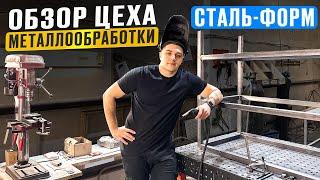
Walking Foot Sewing Machine vs "Walking Foot" Attachment
Комментарии:

On the rare times I have used my walking foot attachment I have reduced the foot pressure. This may be worth trying. But they are certainly not a foot that walks. They simply apply pressure and allow the top to move back and forth with less drag than the standard foot. Could be worthwhile trying the Janome accufeed system as they are very similar to you true walking foot machines. I guess they have their place but certainly doesn't make your machine a walking foot machine. Loving the cats and I am not really a cat person. All the best.
Ответить
Thanks for the info, and I loved your kitty commercial...LOL! Lil hugs
Ответить
The 'Coquina 3000' (spelling?) made me wee myself a little bit. And I'm only 3' 55" in yet...
Ответить
I've struggled with my Singer 201K at every possible setting and with every different needle to sew innertubes, all to no avail. Obviously I'm doing something wrong, but will now look for a walking foot... Cheers.
Ответить
That’s about the outcome I had expected but one never knows without comparing 👍🏻👍🏻👍🏻.
Ответить
Love the Coquina 3000! Wouldn’t you know, we have a similar model—it’s called the Woody 2011 😉
Ответить
Love your sponsor! Unfortunately I don’t think they ship to Australia…
Tremendously informative video though, Jason. Thanks very much!

I have a 2Ku33, similar to the Sailrite. I like it very much except for leather, it leaves the presser foot marks. So instead of the even feed foot or the walking foot, I prefer the roller foot on my Bernina for leather work. The foot pressure will have to be adjusted for various thickness of material, in order for the feed to work properly.
Ответить
I have tried out the Singer Walking Foot attachment. Honestly, not that great. I would rather use the non-stick or Telfon foot for some of the material. Sailrite Worker-B simply too expensive, a good voltage regulator will perform Six-Million-Dollar-Man magic. haha..
Ответить
i have that same Singer walking foot attachment for my old Singer -- they are indeed finicky. when it works, it's great, but sometimes it seems like it's just going to break (and i've had the metal bits pop off and i've had to put them back on in mid-sew before). what this has convinced me of is that i need to find myself one of those Sailright (sp?) machines, haha. great video, as always. (oh, and before i forget: CAT BUTTTTTTT!)
Ответить
Great educational video and the sponsor is adorable!
I wish they would stop naming the different things the same. I love my serger flatlock but couldn't they not name it after a true flatlock? Same with walking feet.
While I made sure to buy a 5mm wide version and not 7mm version (they are for drop in bobbins), I still find that for some fabrics it doesn't improve anything. For example, I don't see why people insist it helps with knits, for me it does not and my machine handles knits well. But it does wonders for stitching the shiny side of PUL or hemming long thick curtains without roping.
Those walking foot machines are mesmerizing, they just literally walk ^_^

great video, shows what you can not sew with the walking foot attachment as this detachment is designed to sew silks, rayons, and the lightest and sheerest of fabrics. These kinds of fabric require a walking foot attachments to keep them from sliding. A great video showing it wont work with medium to heavy fabrics. Its only used in the fashion world,
Ответить
I have a standard home Singer and one of the 607 semi-industrial machines. I use them both regularly. The last two projects were: 1) Sewing junk-yard-obtained seatbelt webbing into soft-tie slings for hanging air hoses, welding leads, garden hoses, and water pump discharge flexible piping from wall hooks and/or ceiling joist hooks. 2) Upholstery Vinyl with black Nylon bias tape for custom tool wrench pouches.
The seatbelt webbing was sewn with the 607 semi-industrial machine. The upholstery Vinyl with the bias tape was accomplished on the standard home Singer machine.
The results of both projects were perfect! There was no way the Nylon bias tape would have attached so smoothly folded over on the raw edge of the upholstery Vinyl without the plastic walking foot installed on the home Singer.
Like any tool, keep within its capabilities and it works just fine.

I recently asked this in some of the FB sewing machine groups and found like I was observing... where at first I thought the Singer walking foot attachment that came with the 206W was broken... it wasn't and most all the attachments claimed to be walking feet aren't really that. Reads/sounds like there is one model attachment that is a semi-walking foot or "even feed" attachment. I did however find there is a Davis vertical feed machine that looks interesting and I wound up finding one for $20 so that was awesome... though waiting on being shipped since I want to be super cost effective and careful so isn't damaged. Would be awesome if I can reverse engineer and fabricate parts to add to one of my White's that are the made in the models with the longer stitch length. That'd be great... and thinking a White FR since I saved so many and can modify one or two custom... like swapping the presser-bar so I can adjust to be low/high or what appears will be better to center the needle in the attachments... slant shank. Thanks for the affirmation and sharing! So much to sewing I need to learn and isn't so much the sewing machine repair and functional restoration work.
Ответить
As you stated the even feed foot is designed for quilting, and in that capacity it works well. You do need to figure out the stitch length that matches the foot as it only 'feeds' at a single length (about 1mm).
I use the teflon foot a lot when doing heavy material. Sometimes it is almost too slippery and I go back to a plain steel foot.
Rubber and home machines do not do well together. I used to sew things using the old army waterproof bags. Nylon with a rubber lining (about 500 denier IIRC). The machine (Singer 15) would do OK on a couple of layers as long as I kept the speed down. More than four layers and the rubber causes the hook not to catch the thread. If I went too fast the needle would heat up and cause all kinds of issues.

Ayaan family vlog Malaysia hgyu ghu
Ответить
Thanks for the video, Jason. I always appreciate your insight and humor. It's great content. I have wondered the same thing: whether a walking foot attachment can perform as well as a dedicated walking foot machine. The results confirm what I had suspected. Thanks again.
Ответить
Ordinary needle?
Ответить
One came with my baby lock, it helped when I made a quilt, it’s nothing compared to my lsz 1
Ответить
Do you suppose it would work with the old Singers? I have fiddled with the other feet and they work........ sometimes.🤓
Ответить
Try a roller foot or Teflon
Ответить
What’s heaviest thread you run through your 237?
Ответить
Doesnt the presser foot tension have to be adjusted when switching from straight foot to the walking foot attachment on the Singer 237 with thicker samples. Some of your samples would lead me to that adjustment I have learned from my own trials and errors. I have messed around with them walking foot attachments and had to adjust the presser foot tension to compensate for the difference in their height adjustments to the feeddogs and different thicknesses of materials being sewn. Just curious?????Good Video !
Ответить
What about using talcum powder?
Ответить
I have an older walking foot attachment like the one you have but paid much less. I used this on my Singer HD when I did insulated blinds. Warm windows insulated curtain fabric is made from 4 layers,then folded upholstery fabric and Velcro. It gave more uniform stitches and I could keep a straighter line than a standard foot. I run the foot pressure high using the walking foot. I have not used it on thin fabric because I never had a problem sewing it with thin fabrics. If I had problems with thin fabric, I would just adjust foot pressure. The sunroom curtains will be done on the Singer HD because it's portable and can go into a big enough space to do a 10' by 59" curtain. If I can't get it to work well enough, I can get my smaller long arm walking foot machine out of my sewing table setup and in the living room.
Ответить
I have never had luck with so called walking feet. I am waiting for someone to make a domestic machine with a two piece walking foot.
Ответить
I have a question. At what point do you move to a WF machine? I'm new to this skill and would like to richest rigs, not so much tactical, but rather more practicalforncivilian enthusiasts.Any suggestions to establish a baseline? Thanks, Mike.
Ответить
Why can't you buy a walking foot for industry plain sewing machine??
Ответить
I would not use a regular sewing machine for stitching leather or rubber. I would use an industrial sewing machine for this.
Ответить
Yes I need this for my socks do u still have any available lol
Ответить
Interesting comparison thank you. I find the bolt on walking foot is excellent for fabrics like silk and velvet, that creep with a normal foot and never finish together. The issue I find with thicker stuff, is getting it under the walking foot fitting in the first place as it sits a bit lower than the standard feet (on both a 1970's Bernina 830 with the Bernina own walking foot, and the Singer 201 with the one you have)
Ответить
good video, informational for sure, bonus pud footage is adorable lol
Ответить
Basically a regular home sewing machine does not have a big stitch length .
Even with the walking foot it doesn't pull the layers of batting at times.
Then foam is not possible at all

Lower the foot pressure ? Do you think the singer attachment might work better so that the upper teeth can help slide the work through and no friction from the static metal foot.
We used to make domestic gas appliances (uk gas fires) and our sheet metal gas burners were stich welded with copper wheel seam spot welder worked in a similar way to your demo, in that the two sheetmetal parts were pulled into the wheels to make then gas tight . We also did some manual seam welding with a foot operated spot welder. This was back in the 1980s.

The walking foot attachement just lets the upper dogs slide with the material as it has no power or syncronisation with the lower feed dogs stitch length. This works ok for some materials . The true walking foot is driving top and bottom in sync ,so no contest really. This Great demo shows it perfectly.
Ответить
That “ad” was PERFECT 😄
Ответить
Cheap generic walking foot help me a lot sewing tricky hem. I bought a new one with open toe.
Ответить
Beautiful black cat. they are the most gentle and friendliest of all cats.
Ответить
love ❤ ur cat .. these felines can never be resisted at any situtions 😁
Ответить
I wouldn't expect a walking-foot attachment to perform anywhere near a true walking foot machine. The foot doesn't actually walk for a start. Technically it's called an equal feed foot. Having said that, I would have expected the attachment to work better than it did. My own experience is that the walking foot attachment does improve the feeding on the Dacron sailcloth I sew quite a lot. Modern sailcloth is very hard and the lower feed dogs can really struggle to get enough grip. These attachments definitely improve the matter even if not a real walking foot. ATB Paula.
Ответить
You talk too much brother😢
Ответить
I have a 237, put on an extra pulley to slow it down, and am considering an add-on walking foot for the work I do--mostly patchng denim jeans and my Carhartt insulated coveralls. Those type materials were not covered here, has anyone else found the added walking foot to help with these materials?
Ответить
I was just looking for a walking foot for my Singer 201. Apparently there are universal feet that claim to be "compatible with." And then there's one with a foot (cut out) that perfectly matches the 201/Featherweight's dogs. I believe it's made by Alphasew and called P60400.
I wanted to mention that in case anyone has a 221 Featherweight, 15, 99, 128, 201 (apparently they all have the same dogs). The universal-fit reportedly don't work as well. (I wonder if that could have been a factor with your 237? ).
EDIT: I received mine. I wouldn't call it a walking foot. I.e., the foot isn't pulling the top fabric. It just pushes down and travels with the fabric (which the machine's dogs are moving as they did before). My first reaction was "this is just a complicated roller foot. Some of the foot's sole moves freely with the fabric. That's all." But, it really works better than the roller foot (even though it's not pulling the fabric). It took me awhile to realize what value it's adding.
Basically: the "walking" foot is applying two stages of foot pressure. The normal machine's pressure on the entire foot. And then targeted pressure directly on top of the machine's dogs (where it's needed). It looks walking, but it's real value is the downward pressure on the dogs beneath making it walk.
It's a confusing topic because I think some really do walk. I've seen "cons" saying you can't do reverse. That would make sense only if the foot's really blindly walking with the needle bar. (I can do reverse, but mine's not walking. It's just downward pressure on the dogs that make it look like it walks.). So, if one of these doesn't really walk, then I think it's important for its "dogs" to fit the machine's dogs (closer fit is better).

The topics of stitch length & foot pressure weren't mentioned. I wonder how important those are. The walking foot's dogs move at a fixed rate. If the machine's stitch length was set to a long length (which looked like it was?), that might not work right if the foot's dogs move at half the length? (Maybe this was taken into account, but not mentioned?). Same thing with foot pressure (I wonder how important that is, if it was dialed in?).
Ответить
Great video !
Ответить
How nice your pet
Ответить
thanks for the information it definitely makes sense
Ответить




![WanMor - Every Pretty Girl In The City [Official Video] WanMor - Every Pretty Girl In The City [Official Video]](https://ruvideo.cc/img/upload/UUxxWDRLQ1VORXc.jpg)




















